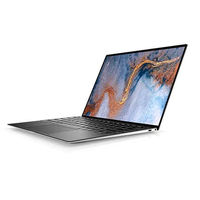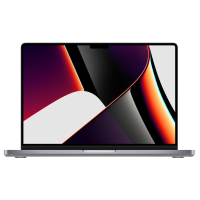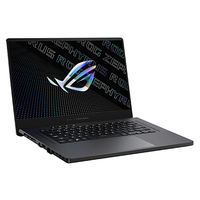TechRadar Verdict
The HP Pavilion 15 carries a fair amount of power and a sharp display in its handsome slimline shell. It's not perfect, but it's a hard worker.
Pros
- +
Decent touchscreen
- +
Plenty of processor heft
- +
Stylish design
Cons
- -
Disappointing battery
- -
No discrete graphics
Why you can trust TechRadar
HP Pavilion 15: Two-Minute Review
The Pavilion line has always represented HP's consumer mid-range marque, and this 15-incher slots right in; it's a not-quite-ultrabook laptop that truly has a lot going for it. The model we have here is absolutely bursting with high-spec hardware, from 16GB RAM to a speedy 512GB SSD, from a touch-screen 15.3-inch FHD display to a 4th-gen AMD Ryzen 7 processor. It's a strong contender for a place on our best laptops list.
For the most part it absolutely rocks those components, getting results which, while not quite reaching as high as the lofty mark set by the top end of Intel's 11th-gen mobile processors, are truly creditable.
All of those guts are packed (literally to the point of bursting) into a handsome and defiantly attractive case, a slim-enough form which looks pricier than it is, and given more than enough ports to make this fully useful no matter what you might have in store for it.
There's a full-size keyboard which feels great to type on, and a large trackpad that didn't let us down. When it comes to day-to-day desktop work, whether it's casual photo editing, web browsing, or 'working' in front of a movie or two, this has what it takes, and doesn't get too hot (or, crucially, too loud) when doing it.
But, of course, we're looking at a $849 (£850, around AU$1,000) laptop here, and for all its ability HP is not known for having the power to pull off miracles. Corners have been cut, though they've been sensibly chosen and are likely to be features you can live without.
There's no keyboard backlight, for example, and as well-braced as the case may be it's entirely plastic. There's also nothing in the way of discrete graphics, so the HP Pavilion 15 is forced to rely on the marginally-better-than-average integrated processor in the Ryzen SoC, something which will likely put off those looking at this as a full-on entertainment laptop or those with specific use cases for creative work.
If you're happy with its limits, we can see no reason not to opt for the HP Pavilion 15. It meets the expectations of its price point perfectly, slotting in next to machines like the Lenovo Thinkbook 15 perfectly. It doesn't feel compromised - at least until you try to launch a game, or spend a long time off-grid reliant on its rather limited battery - and it doesn't look compromised either. If your limits match the HP Pavilion 15's limits, this is a winner.
HP Pavilion 15: Price and Availability
Here is the HP Pavilion 15-eh0014na configuration sent to TechRadar for review:
CPU: AMD Ryzen 7 4700U (2.0 GHz base clock, up to 4.1 GHz max boost clock, 8 MB L3 cache, 8 cores)
Graphics: AMD Radeon Graphics (7-core, 1600MHz)
RAM: 16GB DDR4 (3200MHz)
Screen: 15.6-inch, 1920 x 1080 IPS with touch screen
Storage: 512GB SSD
Ports: 1 x USB Type-C (10Gbps, power delivery, DisplayPort 1.4, HP Sleep and Charge), 2x USB Type-A (5Gbps), 1x HDMI 2.0, 1x combo jack
Connectivity: Realtek RTL8822CE 802.11a/b/g/n/ac (2x2) Wi-Fi and Bluetooth 5.0 combo
Camera: HP Wide Vision 720p camera
Weight: 3.9 pounds (1.75kg)
Size: 14.17 x 9.2 x 0.7 inches (36 x 23.4 x 1.8 cm; W x D x H)
The HP Pavilion 15-eh0014na reviewed here - known also as the eh0015cl - is the big brother of the HP Pavilion 15 family, and as such commands one of the highest prices of HP's mid-range line. That's not to say it's supremely expensive; in the US it can be found for $849.99, while HP's UK store stocks it for £850. In Australia you'll need to settle for the eh0065AU, which omits the touchscreen found here and switches out the 512GB SSD for a 1TB version; it's slightly more eye-watering at AU$2,199, too.
Dial things down in the Pavilion line and you can cut that price significantly; when you're going for a mid-range machine, cutting down things like storage space makes sense, and you may be able to get away with 8GB RAM - though we'd certainly recommend sticking to 16GB if you can afford it.
If you do a spec-by-spec comparison to, say, HP's sleek but premium Envy series, this certainly looks like a better deal, though the Pavilion's lack of discrete graphics means it can do slightly less in the workplace and certainly doesn't have the wide-reaching home potential of the Envy.
A more accurate comparison might be something like the Acer Swift 3, which packs hardware on a reasonably similar (if slightly less powerful) level and touches the same ground in terms of price, too: it's lighter than this, and smaller too, but we think it falls into pretty much the same niche.
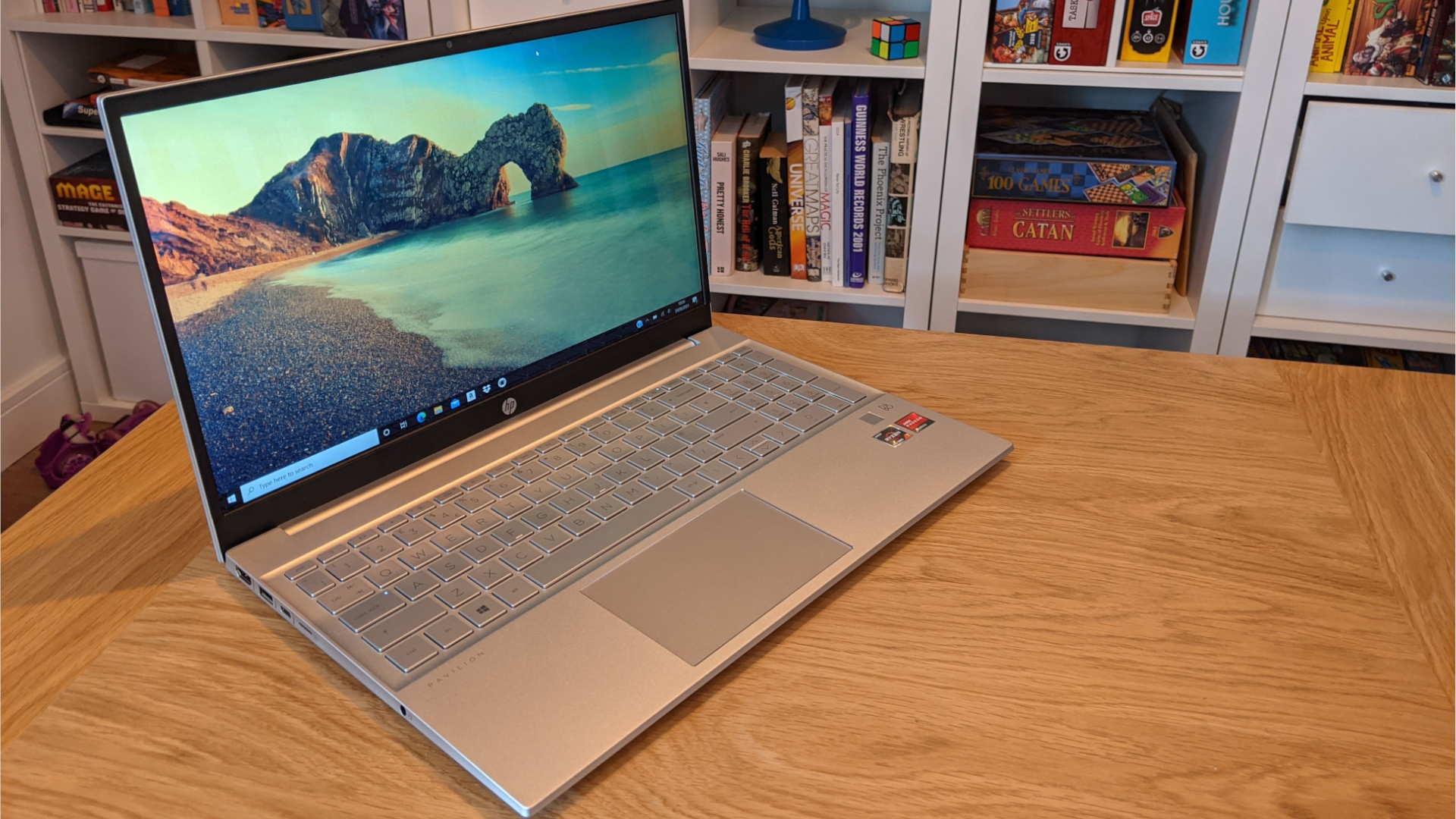
HP Pavilion 15: Design
The Ultrabook category is a tough one to define. If you take the word to mean 'any laptop with the appearance of being slim' then this absolutely slots in there. The HP Pavilion 15- (2021) looks absolutely fantastic for its price point, with HP trimming things back a long way.

The screen, for example, is plenty thin (though made a little bulkier by the subtle protective black rim around the edges) and far stiffer than we'd typically expect for a plastic-cased laptop. It's clearly well-braced inside, because it doesn't have the benefit of a glass front to offer it extra rigidity.
This does make using the touchscreen a little sticker than the same experience on a glass panel, but that's a simple concession that is easily made to hit a price point. The base is similarly svelte-looking, with clever angles used to hide its slightly bulbous belly.
Which does bring us to the other potential meaning of the word Ultrabook, which we'd say was 'any thin and light laptop' - emphasis on the actual thinness and lightness, rather than the implied. It's close, but the HP Pavilion 15 doesn't really qualify. Sure, we've seen bulkier machines out there, and we've seen heavier, but the 15-eh0014na does not slot into either niche exactly. It's not a one-hander like the LG Gram, nor is it sliver-thin like the MacBook Air. It's subtly dense in its own special way.
If we were to guess, it seems HP may even have found a little trouble fitting these Ryzen 7 internals into the chassis. There's a very slight bump to the base; we weren't sure whether it was a trick of the eye having stared at this thing for so long, but a straight edge placed on the rear section reveals that it is indeed slightly bowed. Not something we're deducting any points for, but it's an aesthetic speedbump.
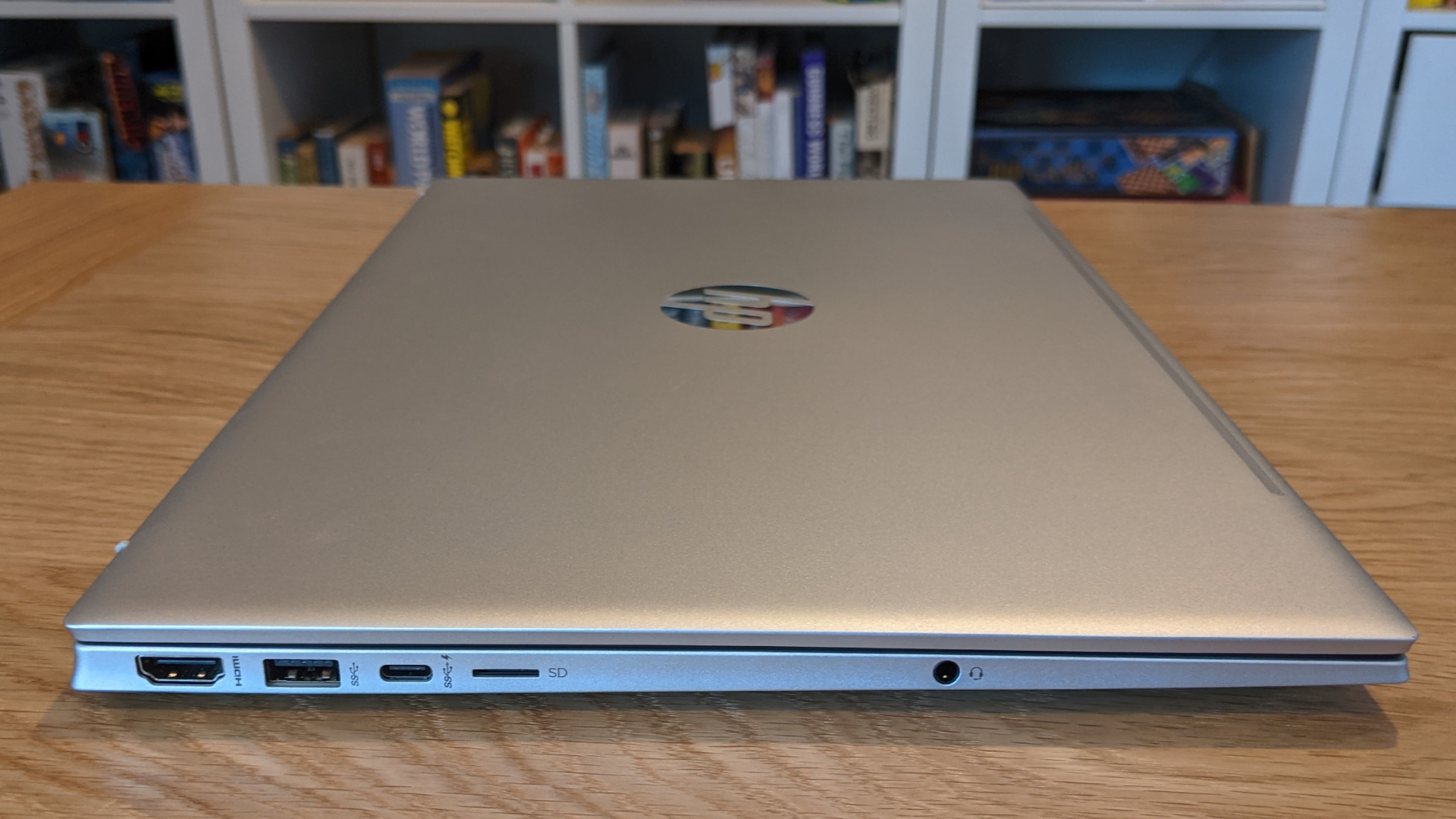
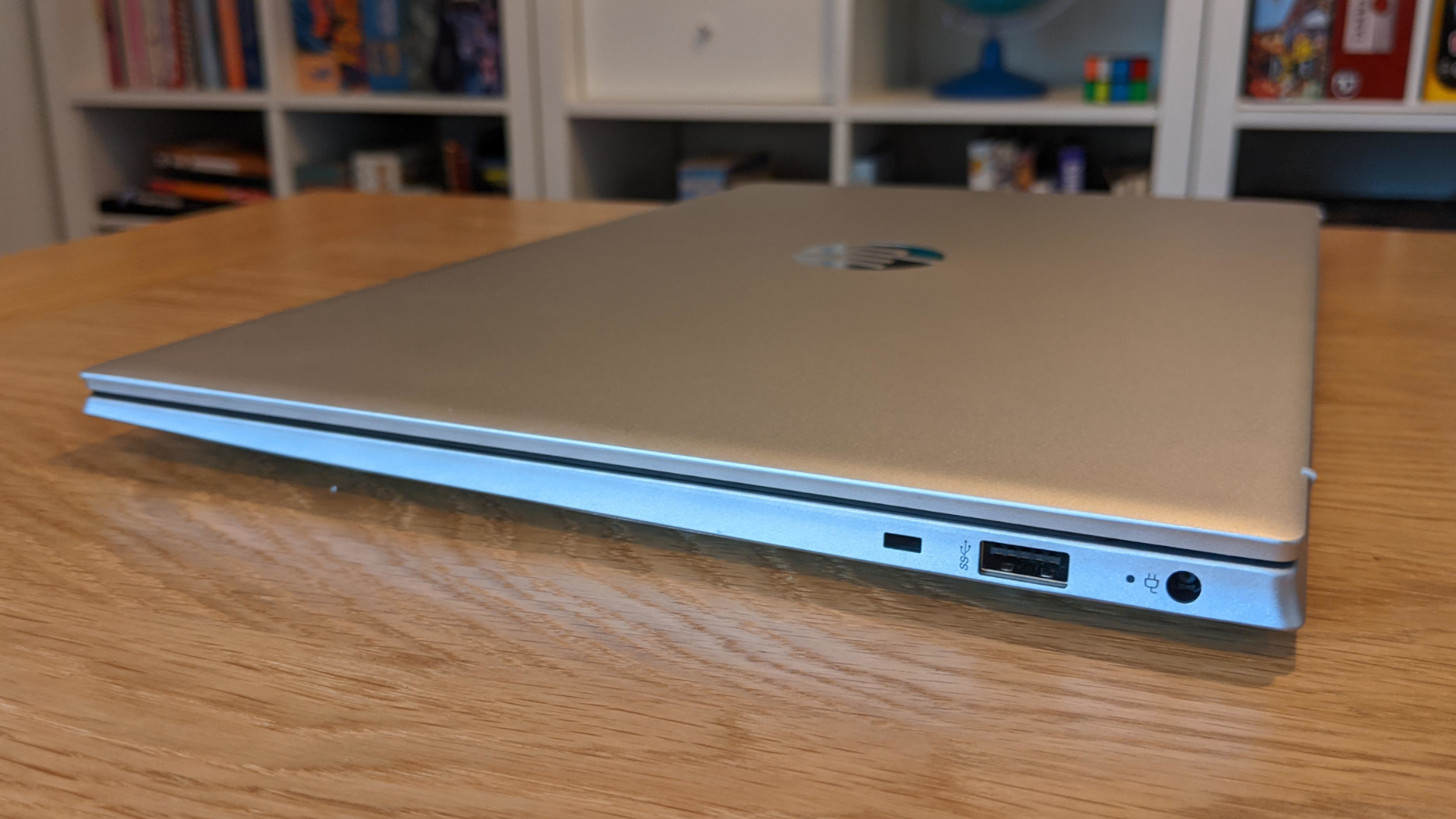
Crammed in it may be, but poorly designed it is not. There's a decent, if not over-generous, amount of port provision, with a USB Type-A socket on each side of the machine, a multi-function Type-C connector on the left, a full-size HDMI output and a built-in microSD reader.
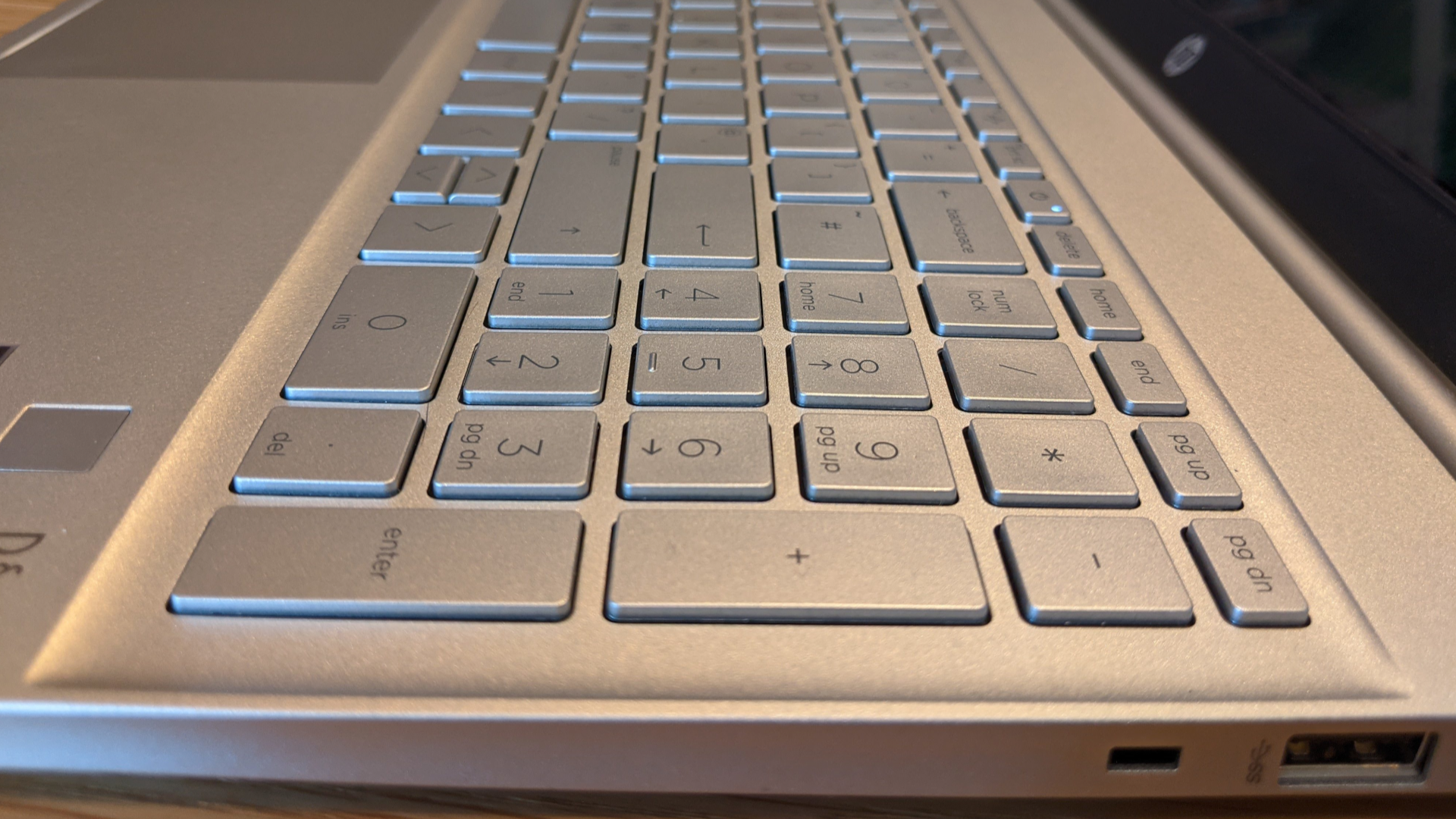
The keyboard sports a full-width tenkey layout which is natural to get used to, and it features minimal flex and decent key travel - we were certainly comfortable, though you may struggle in low light because there's no backlighting on offer. Below it, there's a decent-sized multi-touch trackpad with a convincing click to it, along with a fingerprint reader on the wrist rest.
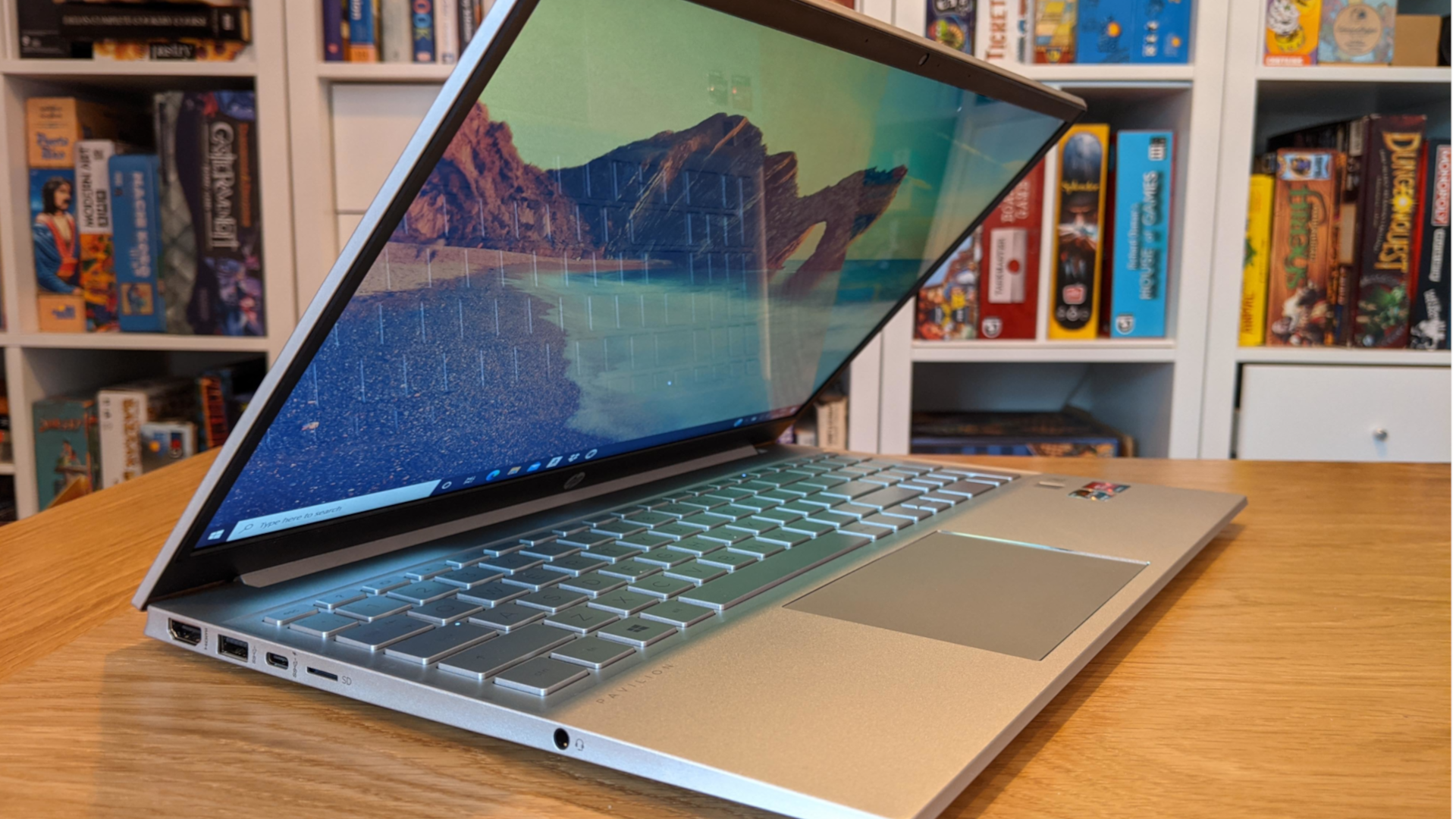
HP Pavilion 15: Performance
Here's how the HP Pavilion 15-eh0014na performed in our suite of benchmark tests:
3DMark: Sky Diver: 10,443; Fire Strike: 2,792; Time Spy: 1,080
Cinebench CPU: 2,883 points
GeekBench 5: 1,095 (single-core); 4,722 (multi-core)
PCMark 10 (Home Test): 5,095 points
PCMark 10 Battery Life: 6 hours and 33 minutes
Battery Life (techradar movie test): 6 hours and 15 minutes
Things are tricky in the laptop market. AMD and Intel are at their traditional loggerheads, and they're playing a game of leapfrog; where the Ryzen 4000-series CPU in this machine may, a few months ago, have been the crown jewel of laptop chips, Intel's 11th-gen processors have now come along and outsparkled it.
The easy conclusion to draw, given that this machine can't quite match its rival's benchmark scores in some departments, would be that this is poor, but that's far from the case. The Ryzen 7 4700U is still a fantastic mobile processor, one which (in conjunction with its fast storage and generous RAM supply) gives this a perfectly snappy feel and helps it keep up easily with day-to-day desktop tasks. This definitely doesn't feel like a lesser laptop.
What it can't do, though, is offer much in the way of gaming performance. You're reliant on the integrated Radeon Graphics solution here which, while not absolutely useless, scores benchmark results in the region of the Nvidia GeForce GTX 960M, a card first launched in 2015. It can cope with esports titles provided they're dialled down a little, but anything more significant will be too much of an ask. Again, though, things feel perfectly slick on the desktop. This isn't sold on its gaming potential, so to penalise it for lacking a discrete graphics solution wouldn't make much sense.
As it is, the package here is enough to provide more than adequate power without requiring too much in the way of cooling or compromise. This simply refuses to get too hot - even when we were really hammering the SoC with benchmarks, the fans rarely ramped up. When they did, they were entirely bearable, and the solid B&O tuned sound system managed to drown them out. We're not over-keep on the down-firing speakers (there has to be a better way) but this works hard.
The screen is decent, though unspectacular. It tops out at 1,920x1,080, giving it enough pixel density that things don't appear obviously grainy to the eye, and is highly reflective - something which helps to bolster the somewhat disappointing contrast of its IPS panel, but which also means this isn't fun to use if you have a window behind you. We've mentioned the sticky touchscreen performance; although we've seen bigger fingerprint magnets, it'll be handy to have a microfiber cloth on hand if you're poking at this panel regularly.
Battery life
HP Pavilion 15: Battery Life
There's no two ways about it: the HP Pavilion 15's battery life is a big disappointment. Given its weight we were expecting this to have a bulky enough battery to last at least a full day's work; as it is, you'd have your work cut out to tease eight hours out of it. Our movie test didn't get far past the six hour mark, and PCMark's battery test managed half an hour more.
Sure, it's not the worst - the cursory batteries of certain gaming laptops can give up the ghost after a couple of hours, and this is far better than that - but it's extra evidence that HP may have run out of space inside the HP Pavilion 15's chassis, or at least cut one little corner too many. Thankfully it does quick-charge, happily reaching half capacity in around half an hour.

Buy it if...
You need a laptop that's perfect for work
This is wonderfully designed and totes a heck of a lot of desktop power, with the added benefit of a decent webcam and a full-sized keyboard. If you're getting down to business on a budget, it's a great fit.
You need a strong screen
While its reflective coating means it's not suitable for every situation, the HP Pavilion 15's display is consistent and decent, with great viewing angles - and the touch screen on this version works well.
You're on a budget
Alright, this isn't exactly a budget laptop, but you do get a lot for your money - a lot of speedy storage, stacks of RAM, a large display, a fast processor, and plenty of modern conveniences, in a shell that belies its price.
Don't buy it if...
You want to work with 3D
The integrated graphics here are not useless, but they're not at the level of a modern discrete graphics solution; they're probably good enough for most uses, but games or hardcore 3D work are out of the question.
You want something that keeps on truckin'
We were disappointed by the HP Pavilion 15's battery life. It's not absolutely pathetic, but we'd expect a little more staying power than this managed, particularly given its weight. Speaking of which...
You want a light laptop
This looks thin, but it's actually a little bit outside the ultrabook category - and it's weighty, too. If you want something you can easily present to someone in one hand, look elsewhere.
Also consider...
Dell XPS 13
If you want a thin and light 13-inch laptop, but prefer Windows, then the Dell XPS 13 is a brilliant alternative, offering a similar level of style and build quality, along with some fantastic specs.
Check out our Dell XPS 13 review
Apple MacBook Pro 14-inch (2021)
If you're after an Apple laptop, then the M1 MacBook Pro 14-inch is well worth considering. It comes with a choice of bulked-up M1 chips in the form of the M1 Pro and M1 Max, offering a huge leap in performance over the Intel MacBook Air. It's a great choice for creative professionals, but it is a lot more expensive.
Check out our Apple MacBook Pro 14-inch (2021) review
Asus ROG Zephyrus G15
If you're after gaming performance, the Zephyrus G15 is probably the de facto best gaming laptop you can buy right now, with high-quality performance and design at an extremely competitive price. The only thing it lacks is a webcam - no video calls here.
Check out our Asus ROG Zephyrus G15 review.
First reviewed May 2021
How We Test
We pride ourselves on our independence and our rigorous review-testing process, offering up long-term attention to the products we review and making sure our reviews are updated and maintained - regardless of when a device was released, if you can still buy it, it's on our radar.

